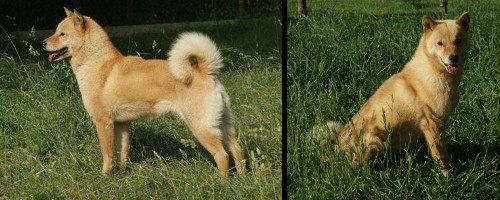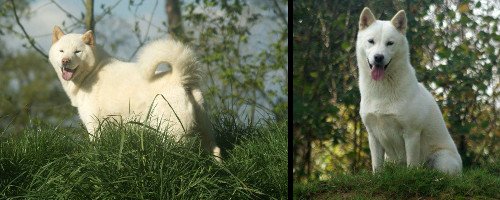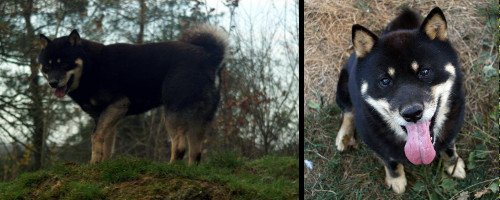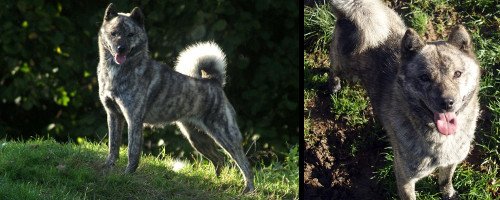
The standard written by the Hokkaido Ken Hozonkai (one of the two main registries for the Hokkaido Ken in Japan) and set on the 11th April 1954 has been kindly translated by Shigeru Kato, and is available on his blog here.
Excerpt:
"Even among the same medium type Nihon Ken, the Hokkaido Ken holds a unique place; a former hunting breed kept by the Ainu, with the build of a hunting dog, its physique forged in the snow and cold. Having this particular adaption and quality gives the Hokkaido Ken standard a particular and unique meaning."
Coat Colours
The Hokkaido Ken comes in six recognised colours. The three more common colours are red, white, black and tan, whilst the three rarer colours - brindle, black and sesame - are rarely seen even inside Japan.
Red

Photo: Benikiku of Nagaregumo Kyuden Kitsune kennel
White

Photo: Left - Satsuki. Right - Nidhøg's Ninigi-no-Mikoto Katsura Kyuden Kitsune kennel
Black and Tan

Photo: Arashi Haru Kaze Kyuden Kitsune kennel
Brindle

Photo: Chiko Yokohama Doken Kaiousou Kyuden Kitsune kennel
Size
The Hokkaido Ken is a medium-sized Japanese breed with females standing at 45.5cm - 48.5cm; and males standing at 48.5cm - 51.5cm to the withers (FCI standard, Japanese bred dogs may stand slightly taller). The ratio of height (to withers) to body length should be 10 : 11 though females may be slightly longer in the body.
Standard (FCI, latest update 2016/10/30)
Cranial Region
Skull and forehead : Broad and slightly flat.
Stop : Shallow, but defined.
Facial Region
Nose: Black. Slight lack of pigmentation in white dogs is accepted.
Muzzle : Wedge-shaped. Nasal bridge straight.
Lips : Tight, with black edges. Blue-Black colour in tongue is not a fault.
Jaws/Teeth : Strong, with a scissor bite.
Cheeks : Well developed.
Eyes : Nearly triangular, not too small, and dark brown in colour. The outer corners of the eyes are slightly upturned.
Ears : Small, triangular, slightly inclining forward and firmly pricked.
Withers : High.
Back : Straight and strong.
Loins : Moderately broad and muscular.
Croup : Properly sloping.
Chest : Forechest well developed. Chest deep and moderately broad; ribs well sprung.
Belly : Slightly tucked up.
Forequarters
Shoulders: Moderately sloping.
Upper arm: Forming a moderate angle with shoulder blade.
Forearm: Straight, clean cut.
Metacarpus (Pastern): Slightly oblique.
Feet: Toes well arched and tightly closed; pads thick and elastic; nails hard and black or dark colour.
Hindquarters
General appearance: Well developed, strong and moderately angulated.
Hocks: Tough, sufficiently strong.
Feet: Toes well arched and tightly closed; pads thick and elastic; nails hard and black or dark colour.
Hair: Outer coat harsh and straight; undercoat soft and dense. The hair on the tail fairly long and off-standing.
Colour: Sesame (mixture of black, red and white hairs in whole), brindle, red, black, black and tan, white.
Any departure from the foregoing points should be considered a fault and the seriousness with which the fault should be regarded should be in exact proportion to its degree and its effect upon the health and welfare of the dog.
